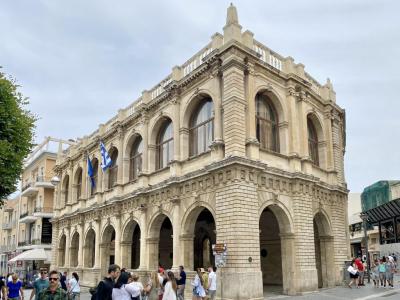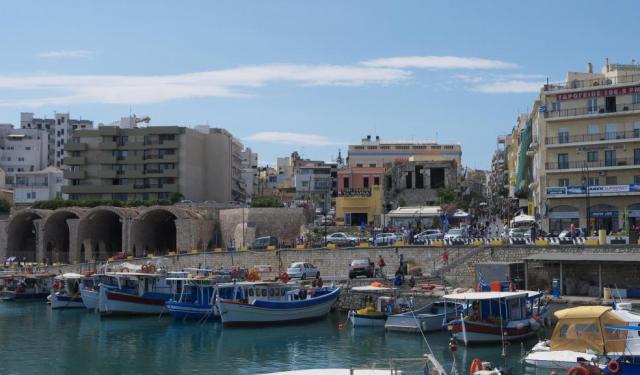
Venetian Loggia, Heraklion
The Venetian Loggia stands as one of the most significant buildings from the Venetian period, offering a glimpse into the historical and cultural tapestry of Heraklion. The term "Loggia," derived from the Italian word for "lodge," hints at the building's original purpose as a gathering place for the elite and affluent members of society.
Constructed after 1541, with probable designs by Michel Sammicheli in the Palladian style, the Loggia underwent a subsequent transformation under the skilled hands of Francisco Morosini after 1628. Morosini, a prominent figure in the Venetian era, left his mark on various monuments in Heraklion, including the Loggia, the Lions Fountain, and the aqueduct that brought water to the city.
Functioning as the fourth iteration of Loggias in Heraklion, the building served as the hub of economic and social life during the Venetian period. A meeting place for discussions on politics and a venue for socializing, the Loggia played a central role in the city's cultural milieu.
During the Turkish occupation, the Loggia endured a shift in purpose, being utilized as an armory and suffering considerable damage. However, with the establishment of the Cretan State in 1915, efforts to restore and renovate the monument began. Unfortunately, the onset of World War II in 1940 disrupted these efforts. It wasn't until 1961 that the comprehensive restoration of the Loggia commenced, culminating in its completion shortly after 1979.
Today, the Venetian Loggia has found a new identity as the City Hall, symbolizing the enduring spirit of Heraklion. Recognized with awards for its meticulous restoration, the Loggia stands proudly as one of the city's paramount monuments.
Constructed after 1541, with probable designs by Michel Sammicheli in the Palladian style, the Loggia underwent a subsequent transformation under the skilled hands of Francisco Morosini after 1628. Morosini, a prominent figure in the Venetian era, left his mark on various monuments in Heraklion, including the Loggia, the Lions Fountain, and the aqueduct that brought water to the city.
Functioning as the fourth iteration of Loggias in Heraklion, the building served as the hub of economic and social life during the Venetian period. A meeting place for discussions on politics and a venue for socializing, the Loggia played a central role in the city's cultural milieu.
During the Turkish occupation, the Loggia endured a shift in purpose, being utilized as an armory and suffering considerable damage. However, with the establishment of the Cretan State in 1915, efforts to restore and renovate the monument began. Unfortunately, the onset of World War II in 1940 disrupted these efforts. It wasn't until 1961 that the comprehensive restoration of the Loggia commenced, culminating in its completion shortly after 1979.
Today, the Venetian Loggia has found a new identity as the City Hall, symbolizing the enduring spirit of Heraklion. Recognized with awards for its meticulous restoration, the Loggia stands proudly as one of the city's paramount monuments.
Want to visit this sight? Check out these Self-Guided Walking Tours in Heraklion. Alternatively, you can download the mobile app "GPSmyCity: Walks in 1K+ Cities" from Apple App Store or Google Play Store. The app turns your mobile device to a personal tour guide and it works offline, so no data plan is needed when traveling abroad.
Venetian Loggia on Map
Sight Name: Venetian Loggia
Sight Location: Heraklion, Greece (See walking tours in Heraklion)
Sight Type: Attraction/Landmark
Guide(s) Containing This Sight:
Sight Location: Heraklion, Greece (See walking tours in Heraklion)
Sight Type: Attraction/Landmark
Guide(s) Containing This Sight:
Walking Tours in Heraklion, Greece
Create Your Own Walk in Heraklion
Creating your own self-guided walk in Heraklion is easy and fun. Choose the city attractions that you want to see and a walk route map will be created just for you. You can even set your hotel as the start point of the walk.
Heraklion Introduction Walking Tour
Heraklion is the vibrant capital of Crete and its primary port. The city traces its roots back to the Minoan era (from 2700 BC to 1450 BC). Under Minoan rule, the area flourished as a vital hub with the nearby palace of Knossos acting as its center of power and trade (in gold, ceramics, and saffron).
Following the Minoans' decline, Crete endured stagnation until the Roman occupation. The... view more
Tour Duration: 2 Hour(s)
Travel Distance: 2.3 Km or 1.4 Miles
Following the Minoans' decline, Crete endured stagnation until the Roman occupation. The... view more
Tour Duration: 2 Hour(s)
Travel Distance: 2.3 Km or 1.4 Miles

